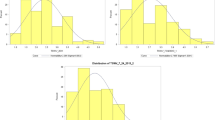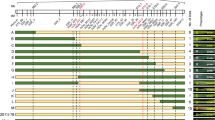Abstract
African wild rice Oryza brachyantha (FF), a distant relative of cultivated rice Oryza sativa (AA), carries genes for pests and disease resistance. Molecular marker assisted alien gene introgression from this wild species to its domesticated counterpart is largely impeded due to the scarce availability of cross-transferable and polymorphic molecular markers that can clearly distinguish these two species. Availability of the whole genome sequence (WGS) of both the species provides a unique opportunity to develop markers, which are cross-transferable. We observed poor cross-transferability (~0.75 %) of O. sativa specific sequence tagged microsatellite (STMS) markers to O. brachyantha. By utilizing the genome sequence information, we developed a set of 45 low cost PCR based co-dominant polymorphic markers (STS and CAPS). These markers were found cross-transferrable (84.78 %) between the two species and could distinguish them from each other and thus allowed tracing alien genome introgression. Finally, we validated a Monosomic Alien Addition Line (MAAL) carrying chromosome 1 of O. brachyantha in O. sativa background using these markers, as a proof of concept. Hence, in this study, we have identified a set molecular marker (comprising of STMS, STS and CAPS) that are capable of detecting alien genome introgression from O. brachyantha to O. sativa.


Similar content being viewed by others
References
Abbasi FM, Shah AH, Perveen F, Afzal M, Sajid M, Masood R, Nawaz F (2010) Genomic affinity between Oryza sativa and Oryza brachyantha as revealed by in situ hybridization and chromosome pairing. Afr J Biotechnol 9(21):3068–3072
Adebayo RA, Salawu EO (2010) Response of some selected rice varieties to infestation by a root-knot nematode, meloidogyne incognita, Chitwood (1949). Int J Agric Res 5:453–459
Aggarwal RK, Brar DS, Khush GS (1997) Two new genomes in the Oryza complex identified on the basis of molecular divergence analysis using total genomic DNA hybridization. Mol Gen Genet 254(1):1–12
Angeles-Shim RB, Vinarao RB, Marathi B, Jena KK (2014) Molecular analysis of Oryza latifolia Desv. (CCDD Genome)-derived introgression lines and identification of value-added traits for rice (O. sativa L.) improvement. J Hered 105(5):676–689
Brar DS, Khush GS (2002) Transferring genes from wild species into rice. In: Kang MS (ed) Quantitative genetics, genomics and plant breeding. CAB International, New York, pp 197–217
Brondani C, Rangel PHN, Borba TCO, Brondani RPV (2003) Transferability of microsatellite and sequence tagged site markers in Oryza species. Hereditas 138:187–192
Chen M, Presting G, Barbazuk WB, Goicoechea JL, Blackmon B, Fang G, Kim H, Frisch D, Yu Y, Sun S, Higingbottom S, Phimphilai J, Phimphilai D, Thurmond S, Gaudette B, Li P, Liu J, Hatfield J, Main D, Farrar K, Henderson C, Barnett L, Costa R, Williams B, Walser S, Atkins M, Hall C, Budiman MA, Tomkins JP, Luo M, Bancroft I, Salse J, Regad F, Mohapatra T, Singh NK, Tyagi AK, Soderlund C, Dean RA, Wing RA (2002) An integrated physical and genetic map of the rice genome. Plant Cell 14:537–545
Chen J, Huang Q, Gao D, Wang J, Lang Y, Liu T, Li B, Bai Z, Luis Goicoechea J, Liang C, Chen C, Zhang W, Sun S, Liao Y, Zhang X, Yang L, Song C, Wang M, Shi J, Liu G, Liu J, Zhou H, Zhou W, Yu Q, An N, Chen Y, Cai Q, Wang B, Liu B, Min J, Huang Y, Wu H, Li Z, Zhang Y, Yin Y, Song W, Jiang J, Jackson SA, Wing RA, Wang J, Chen M (2013) Whole-genome sequencing of Oryza brachyantha reveals mechanisms underlying Oryza genome evolution. Nat Commun 4:1595
Doyle JJ, Doyle JL (1990) Isolation of plant DNA from fresh tissue. Focus 12(1):13–15
Fan C, Walling JG, Zhang J, Hirsch CD, Jiang J, Wing RA (2011) Conservation and purifying selection of transcribed genes located in a rice centromere. Plant Cell 23:2821–2830
Fu SX, Zhan Y, Zhi HJ, Gai JY, Yu DY (2006) Mapping of SMV resistance gene Rsc-7 by SSR markers in soybean. Genetica 128:63–69
Gao LZ, Zhang CH, Jia JZ, Dong YS (2005) Cross-species transferability of rice microsatellites in its wild relatives and the potential for conservation genetic studies. Genet Resour Crop Evol 52:931–940
Gupta PK, Varshney RK (2000) The development and use of microsatellite markers for genetic analysis and plant breeding with emphasis on bread wheat. Euphytica 113:163–185
Hai L, Wagner C, Friedt W (2007) Quantitative structure analysis of genetic diversity among spring bread wheats (Triticum aestivum L.) from different geographical regions. Genetica 130:213–225
Hall TA (1999) BioEdit: a user-friendly biological sequence alignment editor and analysis program for Windows 95/98/NT. Nucl Acids Symp 41:95–98
Hernandez P, Laurie DA, Martin A, Snape JW (2002) Utility of barley and wheat simple sequence repeat (SSR) markers for genetic analysis of Hordeum chilense and tritordeum. Theor Appl Genet 104:735–739
Jena KK, Khush GS (1989) Monosomic alien addition lines of rice: production, morphology, cytology, and breeding behavior. Genome 32:449–455
Jin H, Tan G, Brar DS, Tang M, Li G, Zhu L, He G (2006) Molecular and cytogenetic characterization of an Oryza officinalis-O. sativa chromosome 4 addition line and its progenies. Plant Mol Biol 62:769–777
Konieczny A, Ausubel FM (1993) A procedure for mapping Arabidopsis mutations using co-dominant ecotype-specific PCR-based markers. Plant J 4(2):403–410
Krishnan SG, Waters DLE, Henry RJ (2014) Australian wild rice reveals pre-domestication origin of polymorphism deserts in rice genome. PLoS One 9(6):e98843
Lee HR, Zhang W, Langdon T, Jin W, Yan H, Cheng Z, Jiang J (2005) Chromatin immune precipitation cloning reveals rapid evolutionary patterns of centromeric DNA in Oryza species. Proc Natl Acad Sci USA 102(33):11793–11798
Li G, Hu W, Qin R, Jin H, Tan G, Zhu L, He G (2008) Simple sequence repeat analyses of interspecific hybrids and MAALs of Oryza officinalis and Oryza sativa. Genetica 134:169–180
Lorieux M, Ndjiondjop MN, Ghesquiere A (2000) A first interspecific Oryza sativa x Oryza glaberrima microsatellite-based genetic map. Theor Appl Genet 100:591–601
McCouch SR, Chen X, Panaud O, Temnykh S, Xu Y, Cho YG, Huang N, Ishii T, Blair M (1997) Micro-satellite marker development, mapping and application in rice genetics and breeding. Plant Mol Biol 35:89–99
McCouch SR, Teytelman K, Xu Y, Lobos KB, Clare K, Walton M, Fu B, Maghirang R, Li Z, Xing Y, Zhang Q, Kono I, Yano M, Fjellstrom R, DeClerck G, Schneider D, Cartinhour S, Ware D, Stein L (2002) Development and mapping of 2240 new SSR markers for rice (Oryza sativa L.). DNA Res 9:199–207
Mullan DJ, Platteter A, Teakle NL, Appels R, Colmer TD, Anderson JM, Francki MG (2005) EST-derived SSR markers from defined regions of the wheat genome to identify Lophopyrum elongatum specific loci. Genome 48:811–822
Multani DS, Jena KK, Brar DS (1994) Development of monosomic alien addition lines and introgression of genes from Oryza australiensis domain to cultivated rice Oryza sativa L. Theor Appl Genet 88:102–109
Multani DS, Khush GS, DelosReyes BG, Brar DS (2003) Alien genes introgression and development of monosomic alien addition lines from Oryza latifolia Desv. to rice, Oryza sativa L. Theor Appl Genet 107:395–405
Murashige T, Skoog F (1962) A reviced medium for rapid growth and bioassays with tobacco tissue cultures. Plant Physiol 15:473–497
Olson M, Hood L, Cantor C, Botstein D (1989) A common language for physical mapping of the human genome. Science 245:1434–1435
Panaud O, Chen X, McCouch SR (1996) Development of microsatellite markers and characterization of simple sequence length polymorphism (SSLP) in rice (Oryza sativa L.). Mol Gen Genet 252:597–607
Ramachandran R, Khan Z (1991) Mechanisms of resistance in wild rice Oryza brachyantha to rice leaf folder Cnaphalocrocis medinalis (Guenee) (Lepidoptera: Pyralidae). J Chem Ecol 17(1):41–65
Roder MS, Plaschke J, Konig SU, Borner A, Sorrells ME, Tanksley SD, Ganal MW (1995) Abundance, variability and chromosomal location of microsatellites in wheat. Mol Genet Genomics 2(46):327–333
Sanchez PL, Wing RA, Brar DS (2013) The wild relative of rice: genomes and genomics. In: Zhang Q, Wing RA (eds) Genetics and genomics of rice, plant genetics and genomics: crops and models 5. Springer Science, New York, pp 9–25
Shakiba E, Eizenga GC (2014) Unraveling the secrets of rice wild species. ISBN 978-953-51-1240-2
Uozu S, Ikehashi H, Ohmido N, Ohtsubo H, Ohtsubo E, Fukui K (1997) Repetitive sequences: cause for variation in genome size and chromosome morphology in the genus Oryza. Plant Mol Biol 35:791–799
Van Huynh N (1993) Genetic variation in populations of the yellow stemborer, Scirpophaga incertulas (Walker), and biological basis of resistance of the Oryza sativa (IR56) x Oryza brachyantha hybrid to the pest. Los Banos, Laguna
Vaughan DA (1994) The wild relatives of rice: a genetic resources handbook. International Rice Research Institute, Manila, p 137
Vaughan DA, Morishima H, Kadowaki K (2003) Diversity in the Oryza genus. Curr Opin Plant Mol Biol 6:139–146
Viajante V, Heinrichs E (1986) Rice growth and yield as affected by the whorl maggot Hydrellia philippina Ferino (Diptera: Ephydridae). Crop Prot 5(3):176–181
Wu KS, Tanksley SD (1993) Abundance, polymorphism and genetic mapping of microsatellites in rice. Mol Gen Genet 241:225–235
Yasui H, Iwata N (1991) Production of monosomic alien addition lines of Oryza sativa having a single O. punctata chromosome. In: Rice Genetics II, IRRI, Manila, pp 147–155
Acknowledgments
The authors acknowledge the financial support provided by Director, NRRI to conduct this work.
Author information
Authors and Affiliations
Corresponding author
Ethics declarations
Conflict of interest
All the authors declare that they have no conflicting interest.
Ethical statement
This article does not contain any studies with human participants or animals performed by any of the authors.
Additional information
Communicated by B. Yang.
Electronic supplementary material
Below is the link to the electronic supplementary material.
Fig. S1
Comparative analysis of O. sativa and O. brachyantha genomes. A. Chromosome-size (in Mb) variations in O. sativa (red) and O. brachyantha (blue). B. Relative contribution (in percentage) of each chromosome to constitute the genomes of O. sativa (red) and O. brachyantha(blue). C. Gene content in each chromosome (expressed in terms of percentage of total gene content) of O. sativa (red) and O. brachyantha (red) (JPEG 792 kb)
Fig. S2
PCR analysis using genic STS and CAPS markers belonging to different chromosomes. Name of the markers mentioned at the top of the parentheses. Lanes: Os: Oryza sativa; Ob: Oryza brachyantha; 48: B2-48; M1: 100 bp ladder (Fermentas); M2: 1 kb ladder (Fermentas); M3: 50 bp ladder (Fermentas). (JPEG 1493 kb)
Rights and permissions
About this article
Cite this article
Ray, S., Bose, L.K., Ray, J. et al. Development and validation of cross-transferable and polymorphic DNA markers for detecting alien genome introgression in Oryza sativa from Oryza brachyantha . Mol Genet Genomics 291, 1783–1794 (2016). https://doi.org/10.1007/s00438-016-1214-z
Received:
Accepted:
Published:
Issue Date:
DOI: https://doi.org/10.1007/s00438-016-1214-z
Keywords
- Oryza sativa
- Oryza brachyantha
- Whole genome sequence (WGS)
- Cross-transferable co-dominant molecular markers
- Simple sequence repeats (SSR)
- Sequence tagged microsatellite (STMS)
- Sequence tagged sites (STS)
- Cleaved amplified polymorphic sequence (CAPS)
- Monosomic alien addition line (MAAL)
- Relative gene enrichment index (RGEI)




